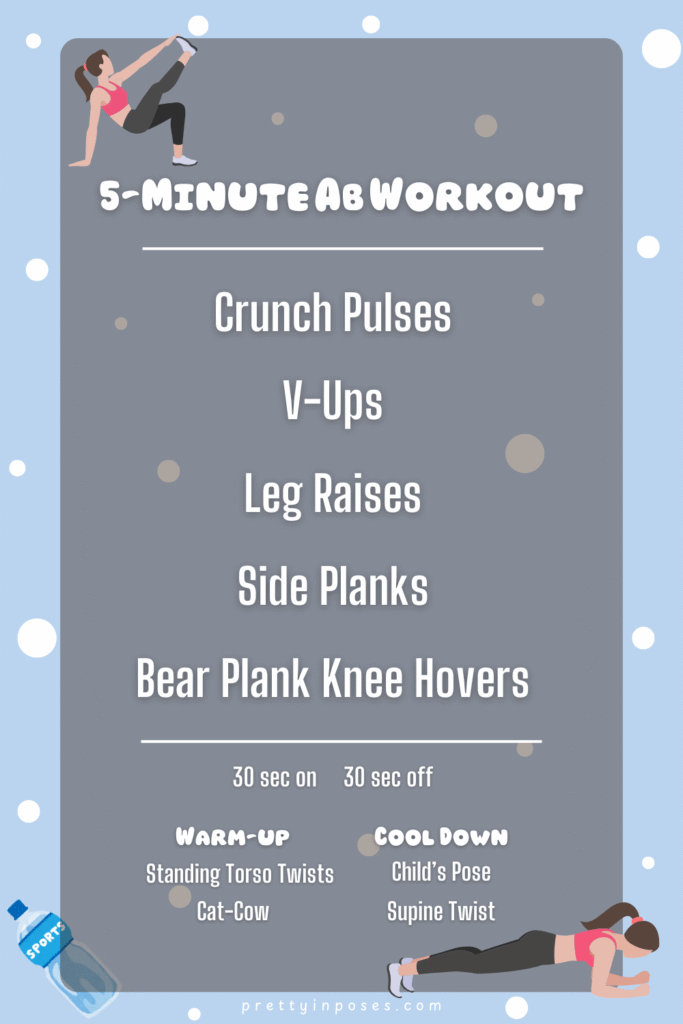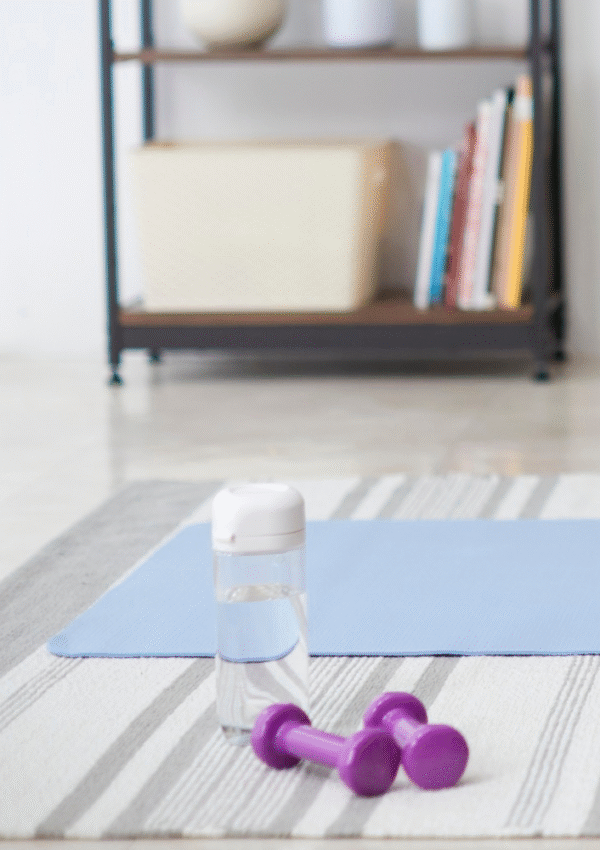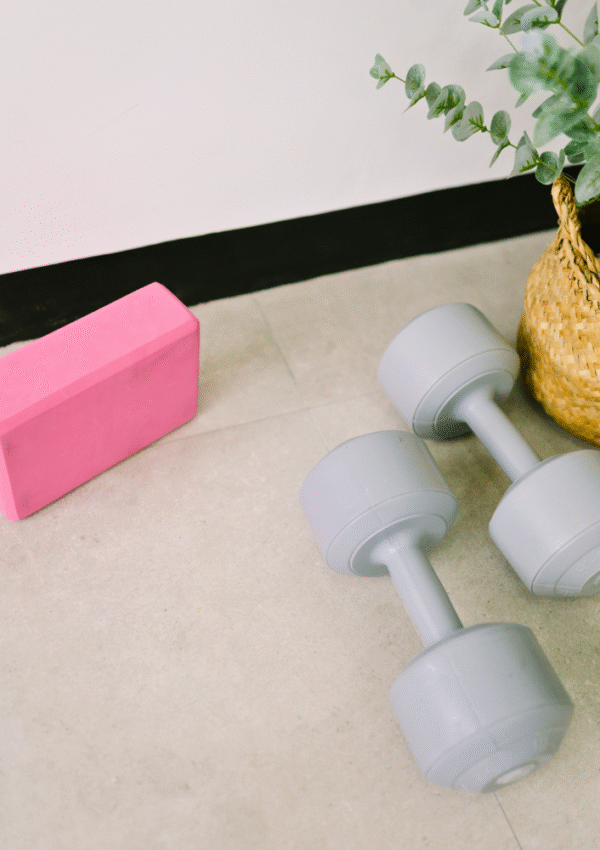Are you looking for the perfect 5-minute ab workout that you can do at home with no equipment? Look no further.
I’ve built a routine that’s super quick, challenging, and — let’s be honest — actually worth your time because I know how hard it can be to squeeze fitness into your schedule.
But I know what you’re thinking: Is 5 minutes really enough? In this post, we’ll answer that very question and share some killer core exercises to boot.
Can a 5 Minute Workout Be Effective?
The simple answer is: yes, 5-minute workouts can be effective—but there’s a caveat. It really depends on your current level of fitness.
If you’re a beginner or live a sedentary lifestyle, you’ll likely get more benefit from these types of workouts.
On the other hand, if you’re used to longer, high-intensity sessions, you probably won’t notice much of a difference.
After all, fitness gains come from challenging your body, and there isn’t a lot of room for progression in such a short time frame.
That said, any amount of exercise is better than none, and there are real advantages to moving your body—even if it’s just for a few minutes.
What Are the Benefits of a 5 Minute Workout?
You may be surprised to learn that bite-sized training can offer benefits similar to extended routines.
Although they’re shorter, these micro workouts can still help burn fat and boost cardiovascular health, particularly when they involve short bursts of movement.
This not only reduces your risk of heart disease but also improves blood circulation and overall endurance.
On top of that, these exercises promote better blood sugar regulation and can give your mood a noticeable lift.
Another plus to a 5-minute workout is that it helps you stay motivated, regardless of your fitness level.
Taking the time to care for your body in this way enhances your dedication, builds self-confidence, and strengthens your skill set.
5 Minute Ab Workout
You’re going to curse my name the first couple of times you try this workout, but after you see the results, you’re going to freaking love me… and I can wait.
Before you start, let me explain how to approach this workout.
The exercises are broken down from novice to advanced—they’re basically the same movements, just modified for each fitness level.
If you’re new to physical activity, do the beginner version straight through. If you’re more experienced, try the next level that suits you best.
Of course, you can mix beginner and advanced exercises if some moves don’t feel challenging enough, but be careful—it’s easy to overwork yourself with ab routines.
Lastly, make sure you’ve been cleared by a medical professional before starting any fitness regimen.
(Keep in mind that you don’t need equipment to perform these workout but you can use them if you want to intensify your workout.)
Crunch Pulses
Crunch pulses are a fun yet soul-crushing exercise that targets your rectus abdominis, aka the upper abs.
I prefer this move over regular crunches because it keeps constant tension on the top of your torso. It’s really going to firm those muscles and help build a tighter core.
How to Perform Crunch Pulses
Lie on your back with your knees bent and feet flat on the floor. Place your hands either behind your head or crossed over your chest.
Lift your shoulders a few inches off the floor and pulse up and down—this isn’t a full crunch, so the movement is small.
Keep your shoulders lifted, but press your lower back firmly into the floor throughout.
Beginners: Keep your hands behind your head and pulse gently.
Intermediate: Place your hands on your chest or extend them straight in front of you.
Advanced: Keep your hands on your chest and hold the pulse at the top for 2 to 3 seconds, or add a 3 to 5 lb weight while crunching
V-Ups
V-ups are one of my favorite core exercises because they work the entire rectus abdominis — both your lower and upper abs.
This move forces your spinal flexors and hip flexors to work together continuously, without a break.
V-ups will leave your whole torso burning, but at least you’ll be building stronger abs while you sweat.
How to Perform V-Ups
Begin this exercise lying on your back with your legs extended flat in front of you and your arms fully stretched overhead.
Then, simultaneously lift your upper and lower body to form a “V” shape. If you can, try to touch your toes with your fingers before lowering back down to the starting position.
Beginners: Start with your knees bent and feet flat on the floor. Hug your knees toward your chest and tap your shins before lowering back down.
Intermediate: Keep your legs and arms straight and perform the exercise as described above.
Advanced: Perform the V-up while holding a 3 to 5-lb weight or pause at the top of each rep for 2 to 3 seconds.
Leg Raises
Leg raises are a pretty sneaky core exercise because they may not look super tough, but they feel super tough.
This move targets your rectus abdominis and transverse abdominis — the deep muscles that wrap around your torso.
Their job is to stabilize your core and spine. These leg raises test your ability to control your hips while strengthening those deep muscles.
How to Perform Leg Raises
Start this exercise lying on your back with your legs and arms extended straight in front of you. You can place your hands under your butt for extra support if you like.
Press your lower back into the floor and tighten your core as you lift your legs toward the ceiling.
Slowly lower your legs back down with control, keeping your lower back pressed into the floor the entire
Beginners: Place your hands beneath your hips and keep your knees bent.
Intermediate: Keep your legs straight and slowly lower them toward the floor, hovering your heels just above the ground.
Advanced: Perform eccentric leg raises by lowering your legs extra slowly (4 to 6 seconds), or hold your heels hovering off the ground for a few seconds before lifting them back up.
Side Planks
Side planks are a simple yet highly effective exercise for building strength. They target the obliques, which are the muscles on the sides of your torso.
This move helps stabilize your core, allowing you to resist bending or twisting forces. Plus, it protects your spine and reduces strain on your lower back.
How to Perform Side Planks
Lie on your side with your elbow directly under your shoulder and your other hand resting on your hip.
Stack your legs on top of each other and lift your hips off the floor. Keep a straight line from your head to your feet and hold the position for the desired time.
Beginners: Do the side plank with your knees bent and resting on the floor.
Intermediate: Extend your legs straight and hold the side plank on your elbow.
Advanced: Stagger your feet by placing the top leg in front of the bottom leg and slowly march your hips up and down.
Bear Plank Knee Hovers
I first discovered bear plank knee hovers through yoga and quickly realized what an incredible exercise they are.
Although they look simple, don’t be fooled — this static hold can really fire up your core.
Bear planks target the transverse abdominis and other core stabilizers, teaching your abs how to brace properly.
Think about those moments when you have to lift something heavy or catch yourself from falling — exercises like this build strength that helps you move safely in everyday life.
How to Perform Bear Plank Knee Hovers
Start on all fours, with your hips positioned above your knees and your shoulders directly over your wrists.
Tuck your toes and lift your knees just a few inches off the floor, keeping them hovering. Maintain a neutral spine and engage your core. Hold this position for the desired amount of time.
Beginners: Gently tap your knees up and down on the floor instead of hovering.
Intermediate: Keep your knees off the floor and hold for time.
Advanced: Add shoulder taps or slowly bring your knee toward your elbow while keeping your knees elevated.
Quick Warm-Up
If you want a quick warm-up, try these exercises before your workout:
Standing Torso Twists (30 sec):
Stand with your feet hip-width apart. Gently twist your torso from side to side, letting your arms swing naturally. Keep your core engaged throughout.
Cat-Cow (30 sec)
Get on all fours. Inhale as you arch your back and lift your head. Exhale as you round your spine and tuck your chin.
Quick Cool-Down
If you want to cool down after the workout, try these simple exercises:
Child’s Pose (30 sec)
Start on all fours, then widen your knees and bring your feet together. Sit your hips back onto your heels with your arms stretched forward.
Rest your forehead on the mat and relax your belly onto your thighs. Breathe deeply.
Supine Twist (30 sec)
Lie on your back with knees bent and arms extended in a “T” shape. Keep your shoulders grounded as you lower your knees to one side. Hold, then switch sides after 30 seconds.
The Core Takeaway
Get it?
That was your 5-minute ab workout—perfect if you’re just starting your fitness journey, short on time, or looking to squeeze in a quick burn.
You can also build on it by adding reps, sets, or time to turn it into a full ab day routine. As you can see, the possibilities are endless.
If you have any questions, drop them in the comments or message me through my contact page. Otherwise, happy ab-building!

Special Thanks
Photo by Taylor Heery on Unsplash






Leave a Reply